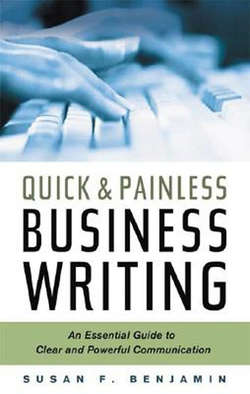Читать книгу Quick & Painless Business Writing: An Essential Guide to Clear and Powerful Communication - Susan F. Benjamin - Страница 4
На сайте Литреса книга снята с продажи.
Section I
Why Quick? Why Painless? Why Not?
ОглавлениеChapter 1
Five No-Worry Reality Checks
Reality Check #1: The Response
Let’s start with the Mother of All Reality Checks – the ultimate reason you write at work. But first, answer this question: Why write at work? Don’t think about your answer – just respond from your gut. A few words will do. Ready? What’s your answer?
If you’re like most of the tens of thousands of people I’ve trained over the years, it probably was: “To communicate,” or “To send information,” or something like that. Actually, writing to communicate is the job of newspapers and magazines. People read them to get information, pass the time, sip a Mimosa on a Sunday morning, and flip through the pages of the Sunday edition.
In the business world, you write to get a response. Writing a proposal? You want the reader to sign on the dotted line. Sending an e-mail asking for material? You want the material, but that’s not all. You want the material now, today, right away. Not, say, after two or three phone calls or follow-up e-mails. Writing a job announcement? Sure, you want people to apply. But you want the right people to apply, and send you the right information when they do. That means, of course, you don’t want the wrong people to apply and have to sift through endless incorrect applications. You know the drill.
The importance of getting the right response is no small matter. In fact, it affects just about everything in your business. Let’s look at that e-mail I mentioned a moment ago. Here’s how it goes:
Hypothetical e-mail scenario: You’re writing a report. Since this is hypothetical, I’m tempted to say the report was for a client and included recommendations that would help them immeasurably and bring you a $2.2 million contract. But your e-mail is probably the more run-of-the-mill variety, such as you and your team are writing a report to help your boss determine the next steps for a project and you need information from another department.
What happened: You sent the e-mail telling your associate in that other department about the project, what you needed, why, and when.
What happened next: Nothing. So you e-mailed again.
And then? Nothing. Still nothing. So you called to remind them.
And: They still didn’t respond, so you found someone else to send the e-mail. Or: They did respond, but you didn’t get everything you wanted. Or: They did respond, only it was late. Or…lots of other possibilities.
Naturally, the cost of this delay adds up. There’s your time spent in e-mailing and calling the person. Then, there’s the time of others on your team who can’t move forward with their contribution to the report until they have the missing information. And at long last, there’s the valuable time of that back-up person you contact since the original (still!) didn’t respond. Plus the stop-and-go time of delaying various aspects of the report and the project, which is on hold since your boss didn’t get the report…Now, multiply this by 10 or even 20 unopened or unanswered e-mails and…well…you know where I’m going.
